2018 MERCEDES-BENZ S-CLASS SEDAN door lock
[x] Cancel search: door lockPage 182 of 562
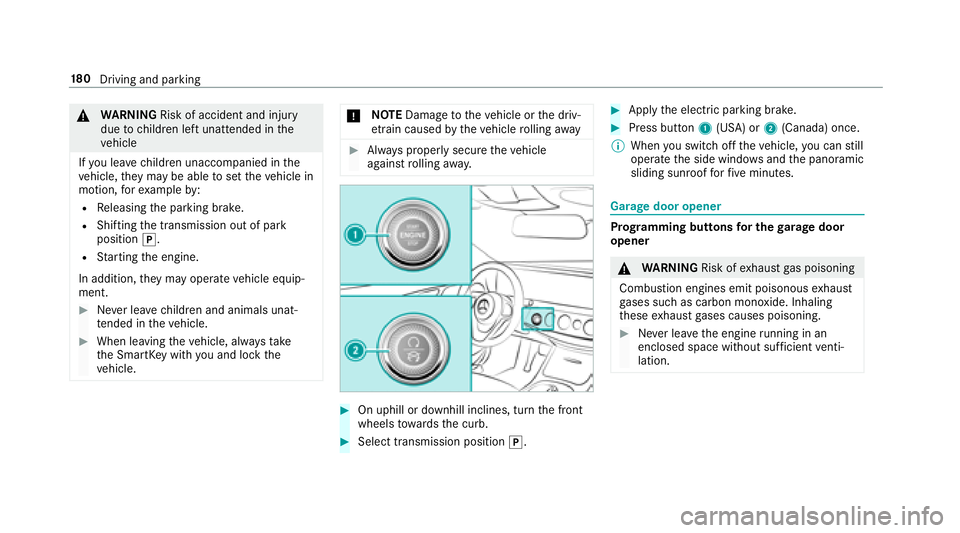
&WARNING Risk of accident and injury
due tochildren left unatte nded inthe
ve hicle
If yo u lea vechildren unaccompanied in the
ve hicle, they may be able toset theve hicle in
motion, forex ample by:
RRe leasing the parking brake.
RShifting the transmission out of park
position j.
RStarting the engine.
In addition, they may operate vehicle equip‐
ment.
#Ne ver lea vechildren and animals unat‐
te nded in theve hicle.
#When leaving theve hicle, alw aysta ke
th e SmartK eywith you and lock the
ve hicle.
* NO
TEDama getotheve hicle or the driv‐
et ra in caused bytheve hicle rolling away
#Alw ays proper lysecure theve hicle
against rolling away.
#On uphill or downhill inclines, turn the front
wheels towa rdsth e curb.
#Select transmission position j.
#Applythe electric parking brake.
#Press button 1(USA) or 2(Canada) once.
% When you switch offtheve hicle, you can still
opera tethe side windo wsand the panoramic
sliding sunroof forfive minutes.
Garage door opener
Prog ramming buttons for the garage door
opener
& WARNING Risk ofexhaust gas poisoning
Combustion engines emit poisonous exhaust
ga ses such as carbon monoxide. Inhaling
th ese exhaust gases causes poisoning.
#Ne ver lea vethe engine running in an
enclosed space wi thout suf ficient venti‐
lation.
18 0
Driving and pa rking
Page 187 of 562
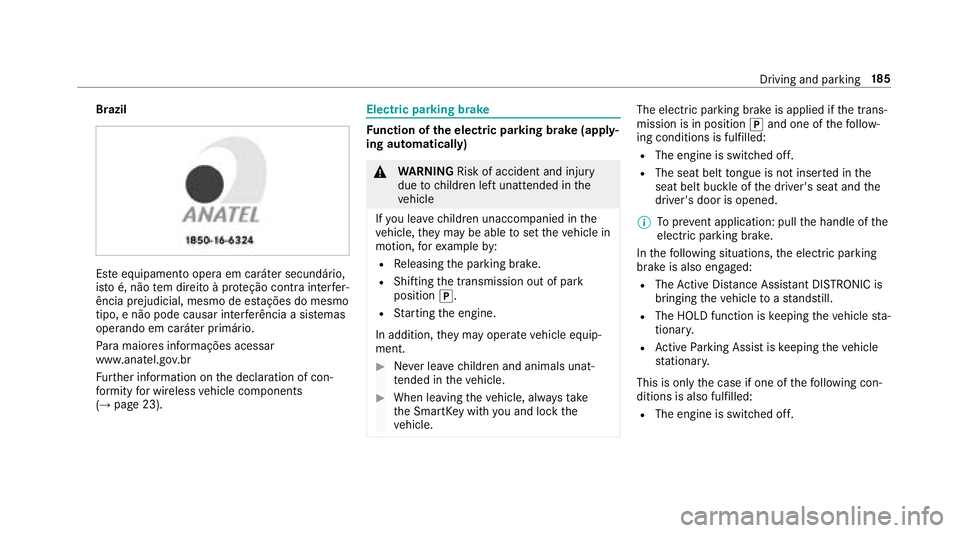
Brazil
Este equipamento opera em caráter secundário,
is to é, não tem direito à pr oteção contra inter fer‐
ência prejudicial, mesmo de es tações do mesmo
tipo, e não pode causar inter ferê ncia a sist emas
operando em caráter primário.
Pa ra maio res informações acessar
www.anatel.go v.br
Fu rther information on the declaration of con‐
fo rm ity for wireless vehicle components
(
→page 23).
Electric parking brake
Fu nction of the electric pa rking brake (app ly‐
ing automatically)
& WARNING Risk of accident and injury
due tochildren left unatte nded inthe
ve hicle
If yo u lea vechildren unaccompanied in the
ve hicle, they may be able toset theve hicle in
motion, forex ample by:
RRe leasing the parking brake.
RShifting the transmission out of park
position j.
RStarting the engine.
In addition, they may operate vehicle equip‐
ment.
#Ne ver lea vechildren and animals unat‐
te nded in theve hicle.
#When leaving theve hicle, alw aysta ke
th e SmartK eywith you and lock the
ve hicle.
The electric parking brake is applied if the trans‐
mission is in position jand one of thefo llow‐
ing conditions is fulfilled:
RThe engine is switched off.
RThe seat belt tongue is not inser ted in the
seat belt buckle of the driver's seat and the
driver's door is opened.
% Toprev ent application: pull the handle of the
electric parking brake.
In thefo llowing situations, the electric parking
brake is also engaged:
RThe Active Dis tance Assist ant DISTRO NIC is
bringing theve hicle toast andstill.
RThe HOLD function is keeping theve hicle sta‐
tionar y.
RActive Parking Assist is keeping theve hicle
st ationar y.
This is only the case if one of thefo llowing con‐
ditions is also fulfilled:
RThe engine is switched off.
Driving and parking 18
5
Page 408 of 562

#Atowing speed of 30 mph (50 km/h)
must not be exceeded.
#Atowing dis tance of 30 miles (50 km)
must not be exceeded.
&
WARNING Risk of accident when towing
a ve hicle which is too heavy
If th eve hicle being tow- star ted or towe d
aw ay is heavier than the permissible gross
mass of your vehicle, thefo llowing situations
can occur:
RThe towing eye may become de tach ed.
RThe vehicle/trailer combination may
swer veoreve nov erturn.
#If ano ther vehicle is tow- star ted or
to we daw ay, its weight must not exceed
th e permissible gross mass of your ow n
ve hicle.
If a vehicle must be tow- star ted or towe daw ay,
its weight must not exceed the permissible gross
mass of theto wing vehicle.
#Information on the permissible gross mass of
th eve hicle can be found on theve hicle iden‐
tification plate (
→page 445).
#Do not open the driver's door or front
passenger door, otherwise the automatic
transmission automatically shifts toposition
j.
#Ins tallth eto wing eye (→page 409).
#Attach theto w bar.
* NO
TEDama gedue toincor rect connec‐
tion
#Only connect theto w rope or tow bar to
th eto wing eyes.
#Deactivate the automatic locking mechanism
(→page 64).
#Do not activate the HOLD function.
#Deactivate Active Brake Assi st(→page 196).
#Shift the automatic transmission toposition
i.
#Re lease the electric parking brake.
&
WARNING Risk of accident due tolimi‐
te d saf ety-re lated functions during the
to wing process
Saf ety-re lated functions are limited or no lon‐
ge rav ailable in thefo llowing situations:
Rth e ignition is switched off.
Rthe brake sy stem or po werst eering sys‐
te m is malfunctioning.
Rth e energy supply or the on-board electri‐
cal sy stem is malfunctioning.
When your vehicle is then towe daw ay, signif‐
icantly more ef fort may be requ ired tosteer
and brake than is no rmally requ ired.
#Use a tow bar.
#Make sure that thesteering wheel can
mo vefreely, before towing theve hicle
aw ay.
406
Breakdown assis tance
Page 440 of 562
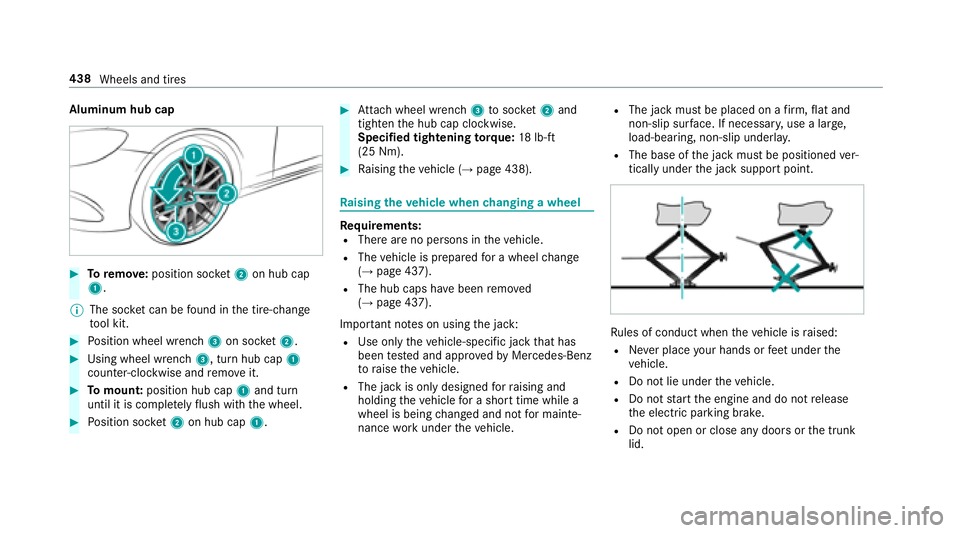
Aluminum hub cap
#Toremo ve:position soc ket2 on hub cap
1.
% The soc ket can be found inthe tire-change
to ol kit.
#Po sition wheel wrench 3on soc ket2.
#Using wheel wrench 3, turn hub cap1
counter-clo ckwise and remo veit.
#To mount: position hub cap 1and turn
until it is compl etely flush withth e wheel.
#Po sition soc ket2 on hub cap 1.
#Attach wheel wrench 3tosoc ket2 and
tighten the hub cap clockwise.
Specified tightening torq ue: 18lb-ft
(25 Nm).
#Ra ising theve hicle (→page 438).
Ra ising theve hicle when changing a wheel
Re quirements:RThere are no persons in theve hicle.
RThe vehicle is prepared for a wheel change
(→page 437).
RThe hub caps ha vebeen remo ved
(→page 437).
Impor tant no tes on using the jack:
RUse only theve hicle-specific jack that has
been tested and appr oved byMercedes-Benz
to raise theve hicle.
RThe jack is only designed forra ising and
holding theve hicle for a short time while a
wheel is being changed and not for mainte‐
nance workunder theve hicle.
RThe jack must be placed on a firm ,fl at and
non-slip sur face. If necessar y,use a lar ge,
load-bearing, non-slip underla y.
RThe base ofthe jack must be positioned ver‐
tically under the jack support point.
Ru les of conduct when theve hicle is raised:
RNe ver place your hands or feet under the
ve hicle.
RDo not lie under theve hicle.
RDo not start the engine and do not release
th e electric parking brake.
RDo not open or close any doors or the trunk
lid.
438 Wheels and tires
Page 499 of 562
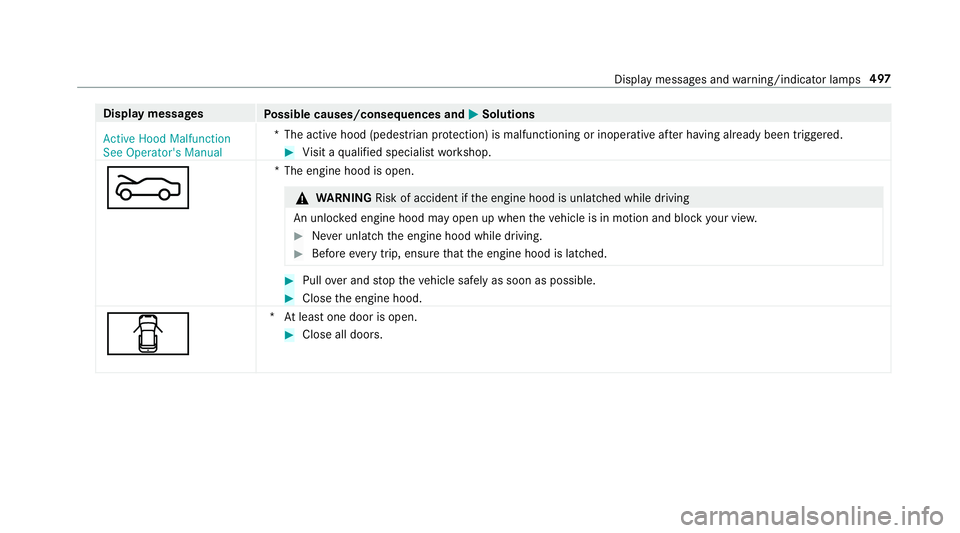
Displaymessages
Possible causes/consequences and MSolutions
�$�F�W�L�Y�H �+�R�R�G �0�D�O�I�X�Q�F�W�L�R�Q
�6�H�H �2�S�H�U�D�W�R�U�
�V �0�D�Q�X�D�O *T
he active hood (pedestrian pr otection) is malfunctioning or inoperative af ter having already been triggered.
#Vi sit a qualified specialist workshop.
M
*T he engine hood is open.
&
WARNING Risk of accident if the engine hood is unlatched while driving
An unloc ked engine hood may open up when theve hicle is in motion and block your vie w.
#Never unlatch the engine hood while driving.
#Before every trip, ensure that the engine hood is latched.
#Pull over and stop theve hicle safely as soon as possible.
#Close the engine hood.
C
*A t least one door is open.
#Close all doors.
Displ aymessage s andwarning/indicator lamps 497
Page 523 of 562

Air suspensionsee AIR BODY CONTROL
Air vents ................................................... 162
Ad justing (front) .................................. 162
Ad justing (rear) .................................... 163
Glo vebox .............................................1 64
Re ar cen ter air vent ............................. 163
Re ar side air vent ................................. 163
Air vents
see Air vents
Ai r-re circulation mode ............................ 160
Alarm see Panic alarm
Alarm sy stem
see ATA (anti-theft alarm sy stem)
Alternative route
see Route
Amb ient lighting ...................................... 148
Android Auto ............................................ 326
Connecting a mobile phone ................. 326
Ending ................................................. 327
No tes .................................................. 326
Overview ............................................. 326 Sound settings .................................... 327
Tr
ans ferred vehicle data ......................3 27
Animals Pets in theve hicle ................................. 56
Anti-lock braking sy stem
see ABS (Anti-lock Braking Sy stem)
Anti-theft alarm sy stem
see ATA (anti-theft alarm sy stem)
Anti-theft pr otection
Immobilizer ............................................ 86
Anti- theft pr otection
see ATA (
anti-theft alarm sy
stem)
Anticipatory occupant pr otection
see PRE- SAFE
®(anticipatory occu‐
pant pr otection)
see PRE-SAFE
®PLUS (anticipatory
occupant pr otection plus)
Apple CarPlay™ ....................................... 324
Connecting an iPhone
®....................... 325
Ending ................................................ .326
No tes .................................................. 325
Overview ............................................. 324
Sound settings .................................... 325 Tr
ans ferred vehicle data ......................3 27
Asht ray
Fr ont center console ........................... 132
Re ar door ............................................ .132
Assistance graphic
Menu (on-board computer) .................. 248
Assistance sy stems
see Driving saf etysy stem
ASS YST PLUS ........................................... 377
Battery disconnection periods ............. 378
Displ aying the service due date ........... 377
Fu nction/no tes ................................... 377
Re gular service work ........................... 377
Special service requ irements .............. 377
ATA (anti-theft alarm system) .................. 86
Deactivating the alarm .......................... 87
Fu nction ................................................ 86
AT TENTION ASSIST ......................... 232, 233
Fu nction ........................ ...................... 232
Setti
ng ................................................. 233
Sy stem limitations .............................. .232
At tention assistant
see ATTENTION ASSIST
Index 521
Page 527 of 562
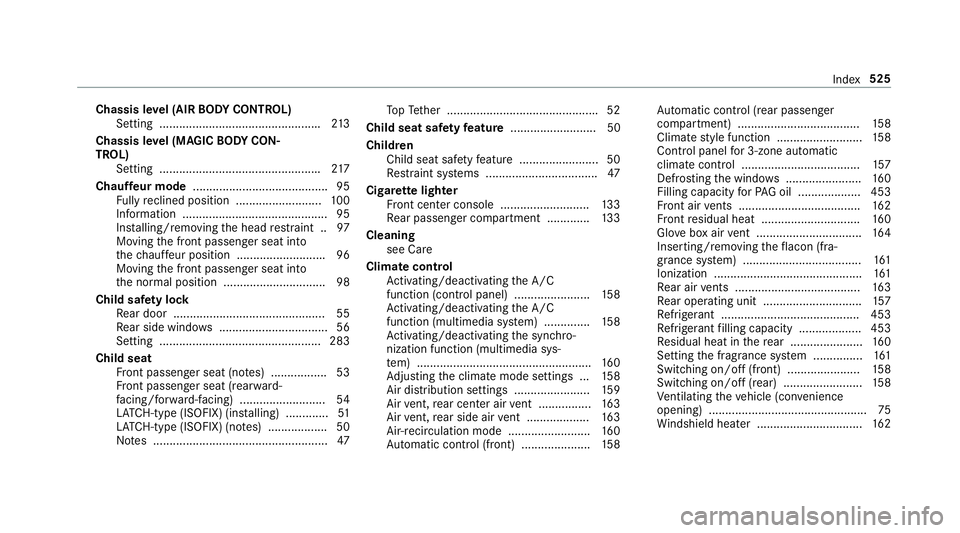
Chassis level (AIR BODY CONT ROL)
Setting ................................................ .213
Chassis le vel (MAGIC BODY CON‐
TROL)
Setting ................................................ .217
Chauf feur mode ......................................... 95
Fu lly reclined position .......................... 100
Information ............................................ 95
Ins talling/ removing the head restra int .. 97
Moving the front passenger seat into
th ech auf feur position .......................... .96
Moving the front passenger seat into
th e normal position .............................. .98
Child saf ety lock
Re ar door .............................................. 55
Re ar side wind ows................................. 56
Setting ................................................. 283
Child seat Front passenger seat (no tes) ................. 53
Fr ont passenger seat (rear ward-
fa cing/for ward-facing) .......................... 54
LA TC H-type (ISOFIX) (ins talling) ............ .51
LA TC H-type (ISOFIX) (no tes) .................. 50
No tes ..................................................... 47To
pTe ther ............................................. .52
Child seat saf etyfe ature .......................... 50
Children Child seat saf etyfe ature ........................ 50
Re stra int sy
stems ..
............................... .47
Cigar ette lighter
Fr ont center console ........................... 133
Re ar passenger compartment ............ .133
Cleaning see Ca re
Climate control Activating/deactivating the A/C
function (cont rol panel) ...................... .158
Ac tivating/deactivating the A/C
function (multimedia sy stem) .............. 158
Ac tivating/deactivating the synchro‐
nization function (multimedia sys‐
te m) ..................................................... 160
Ad justing the climate mode settings ... 158
Air di stribution settings .......................1 59
Air vent, rear cen ter air vent ................ 163
Air vent, rear side air vent ................... 163
Air-reci rculation mode .. .......................160
Au tomatic control (front) .....................1 58Au
tomatic control (rear passenger
compartment) ..................................... 158
Climate style function .......................... 158
Control panel for 3-zone au tomatic
climate control .................................... 157
Defrosting the windo ws....................... 160
Filling capacity forPA G oil .................. .453
Fr ont air vents ..................................... 162
Fr ont residual heat .............................. 160
Glo vebox air vent ................................ 164
Inserting/removing theflacon (fra‐
gr ance sy stem) ............ .....
...................
161
Ionization ............................................. 161
Re ar air vents ...................................... 163
Re ar operating unit .............................. 157
Re frigerant .......................................... 453
Re frigerant filling capacity .................. .453
Re sidual heat in there ar ...................... 160
Setting the fragrance sy stem ............... 161
Switching on/off (front) ...................... 158
Switching on/off (rear) ........................ 158
Ve ntilating theve hicle (con venience
opening) ................................................ 75
Wi ndshield hea ter ................................ 162
Index 525
Page 533 of 562
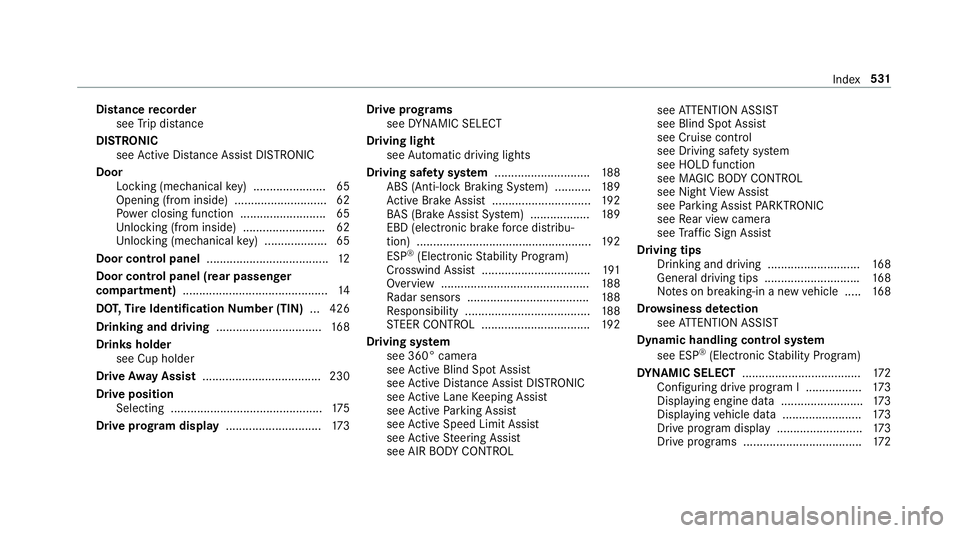
Distancerecorder
see Trip dis tance
DI STRO NIC
see Active Dis tance Assist DISTRONIC
Door Locking (me chanical key) ...................... 65
Opening (from inside )............................ 62
Po we r closing function .......................... 65
Un locking (from inside) ........................ .62
Un locking (mechanical key) .................. .65
Door cont rol panel .................................... .12
Door cont rol panel (rear passenger
compartment) ............................................ 14
DO T,Tire Identification Number (TIN) ... 426
Drinking and driving ................................168
Drink sholder
see Cup holder
Driv eAwa y Assist .................................... 230
Drive position Selecting .............................................. 175
Driv eprog ram display ............................. 173 Driv
eprog rams
see DYNA MIC SELECT
Driving light see Automatic driving lights
Driving saf ety sy stem ............................ .188
ABS (Anti-lock Braking Sy stem) ........... 189
Ac tive Brake Assi st.............................. 192
BA S (Brake Assist System) .................. 189
EBD (electronic brake forc e distribu‐
tion) ................................. .....
...............
192
ESP®(Electronic Stability Prog ram)
Crosswind Assist ................................. 191
Overview ............................................. 188
Ra dar sensors .................................... .188
Re sponsibility ...................................... 188
ST EER CONTROL ................................. 192
Drivin gsy stem
see 360° camera
see Active Blind Spot Assi st
see Active Dis tance Assist DISTRONIC
see Active Lane Keeping Assist
see Active Parking Assist
see Active Speed Limit Assi st
see Active Steering Assist
see AIR BODY CONTROL see
ATTENTION ASSIST
see Blind Spot Assist
see Cruise contro l
see Driving saf etysy stem
see HOLD function
see MAGIC BODY CONTROL
see Night View Assist
see Parking Assist PARKTRONI C
see Rear view camera
see Traf fic Sign Assist
Drivin gtips
Drinking and drivin g............................ 168
Gene ral driving tips ............................ .168
No tes on breaking-in a new vehicle ..... 168
Dr ow siness de tection
see ATTENTION ASSIST
Dynamic handling control sy stem
see ESP
®(Elect ronic Stability Prog ram)
DY NA MIC SELECT ....................................1 72
Confi guring drive program I ................. 173
Displ aying engine data .
....................... .173
Displ aying vehicle data ........................ 173
Drive prog ram display ..........................1 73
Drive prog rams ....................................1 72
Index531